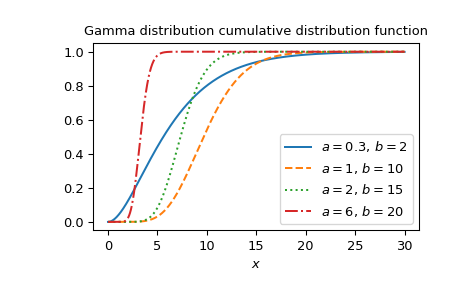scipy.special.gdtr#
- scipy.special.gdtr(a, b, x, out=None) = <ufunc 'gdtr'>#
伽马分布累积分布函数。
返回伽马概率密度函数从零到 x 的积分,
\[F = \int_0^x \frac{a^b}{\Gamma(b)} t^{b-1} e^{-at}\,dt,\]其中 \(\Gamma\) 是伽马函数。
- 参数:
- a类数组
伽马分布的速率参数,有时表示为 \(\beta\) (浮点数)。它也是尺度参数 \(\theta\) 的倒数。
- b类数组
伽马分布的形状参数,有时表示为 \(\alpha\) (浮点数)。
- x类数组
分位数(积分上限;浮点数)。
- outndarray, 可选
可选的函数值输出数组
- 返回:
- F标量或 ndarray
在 x 处评估的参数为 a 和 b 的伽马分布的 CDF。
另请参阅
gdtrc1 - 伽马分布的 CDF。
scipy.stats.gamma伽马分布
备注
通过与不完全伽马积分(正则化伽马函数)的关系进行评估。
Cephes [1] 例程
gdtr的封装。直接调用gdtr可以比调用scipy.stats.gamma的cdf方法快得多,尤其对于小型数组或单个值。要获得相同的结果,必须使用以下参数化:stats.gamma(b, scale=1/a).cdf(x)=gdtr(a, b, x)。参考文献
[1]Cephes 数学函数库, http://www.netlib.org/cephes/
示例
计算
a=1,b=2在x=5处的函数值。>>> import numpy as np >>> from scipy.special import gdtr >>> import matplotlib.pyplot as plt >>> gdtr(1., 2., 5.) 0.9595723180054873
通过为 x 提供 NumPy 数组,计算
a=1和b=2在多个点的函数值。>>> xvalues = np.array([1., 2., 3., 4]) >>> gdtr(1., 1., xvalues) array([0.63212056, 0.86466472, 0.95021293, 0.98168436])
gdtr可以通过为 a、b 和 x 提供广播兼容形状的数组来评估不同的参数集。这里我们计算三个不同的 a 在四个位置 x 和b=3处的函数值,得到一个 3x4 数组。>>> a = np.array([[0.5], [1.5], [2.5]]) >>> x = np.array([1., 2., 3., 4]) >>> a.shape, x.shape ((3, 1), (4,))
>>> gdtr(a, 3., x) array([[0.01438768, 0.0803014 , 0.19115317, 0.32332358], [0.19115317, 0.57680992, 0.82642193, 0.9380312 ], [0.45618688, 0.87534798, 0.97974328, 0.9972306 ]])
绘制四个不同参数集的函数图。
>>> a_parameters = [0.3, 1, 2, 6] >>> b_parameters = [2, 10, 15, 20] >>> linestyles = ['solid', 'dashed', 'dotted', 'dashdot'] >>> parameters_list = list(zip(a_parameters, b_parameters, linestyles)) >>> x = np.linspace(0, 30, 1000) >>> fig, ax = plt.subplots() >>> for parameter_set in parameters_list: ... a, b, style = parameter_set ... gdtr_vals = gdtr(a, b, x) ... ax.plot(x, gdtr_vals, label=fr"$a= {a},\, b={b}$", ls=style) >>> ax.legend() >>> ax.set_xlabel("$x$") >>> ax.set_title("Gamma distribution cumulative distribution function") >>> plt.show()

伽马分布也可以通过
scipy.stats.gamma获得。直接使用gdtr比调用scipy.stats.gamma的cdf方法快得多,尤其对于小型数组或单个值。要获得相同的结果,必须使用以下参数化:stats.gamma(b, scale=1/a).cdf(x)=gdtr(a, b, x)。>>> from scipy.stats import gamma >>> a = 2. >>> b = 3 >>> x = 1. >>> gdtr_result = gdtr(a, b, x) # this will often be faster than below >>> gamma_dist_result = gamma(b, scale=1/a).cdf(x) >>> gdtr_result == gamma_dist_result # test that results are equal True